ABSTRACT
The development of production technologies, such as greenhouses, was highlighted in the growth of horticultural crops. However, these products are often offered without basic instructions to farmers who can generate financial losses. One outstanding production technology is substrate cultivation, which would be very useful in the cultivation of protected plants. Like this, in order to evaluate the effects of different doses of phosphorus on the production of tomato groups grown in substrate under greenhouse conditions, a randomized complete block design was used in a 2 x 5 factorial scheme, with two tomato groups: Santa Cruz "Debora Max" and Cherry "Coco" x five rates of P2O5 (0; 33; 66; 99 and 132 g; 10 L of nutrient solution) with four replicates. The results showed that the electrical conductivity inside the Slabs is not homogeneous, being recommended to wet the substrate inside the slabs, before the planting to reduce the electrical conductivity. In relation to phosphorus efficiency, the highest tomato yield was for the 6.6 g L-1 phosphorus dose for the two Santa Cruz and Cherry groups. The main advantage of using slabs in tomatoes is the efficiency of the phosphorus used in the first planting.
Key words: Lycopersicon esculentum, substrate, slabs, phosphorus, fertilization.
The tomato Lycopersicon esculentum Mill is one of the main vegetables produced in Brazil, arriving at the market in an in natura or processed way. The tomato production chain reached more than 37 million tons in 2010, for global parameters, consolidating the chain as one of the main agribusiness. By 2016, according to estimates by the World Tomato Processing Council, the amount should reach more than 39.3 million tonnes. Most of the production, near 97%, is concentrated in the 10 largest producers, which accumulate around 34.1 million tons. Brazil is in eighth place with 1.25 million tons produced (Carvalho et al., 2016). In order to improve tomato yield and meet increasing demand, new technologies have been adopted, among which the production in a protected environment stands out (Cararo and Duarte, 2002).
The cultivation in a protected environment provides better accommodation of the plants against undesirable climatic factors, reducing the risks of tomato cultivation, besides allowing the production of fruits in times not favorable to the conduction of planting in the open field (Alvarenga, 2004). The technique of cultivation in protected environment using substrate has been generalized to allow better nutrient absorption, higher productivity, better product quality and facilitation of the implementation of cultural practices (Gul et al., 2005). Gualberto et al. (2002) comments that this system has many advantages that include the high quality and yield of the crop, lower fertilizer losses and the better use of water, besides the reduction in environmental pollution and greater control and efficiency in the process productive. Riviere and Caron (2001) report that substrate cultivation is effective in protecting crop pathogens from soil and, despite the high cost and demanding a better technological level, this technique has attracted producers from several countries.
The material that is used in this research is ‘’slabs’’ that are bags with dimensions that vary from 1.50 x 50 cm in width that, when filled, are 30 cm in diameter. The material was designed in 2010, after several attempts of cultivation in pots, bags for seedlings, cultivation channels, the system is widely used in developed countries (Holler, 2015). The research carried out in Brazil indicated the possibility of tomato production on substrate (Loures et al., 1998). However, regarding the correct supply of nutrients in the substrate, there are still many problems related to fertilization, which can increase the electrical conductivity in canopy plants (Blanco et al., 2002). Although irrigation water in protected crops is of good quality, the addition of fertilizers, when using the fertigation technique, makes it saline, increasing the risk of salinization, especially potassium chloride, which has high salinity (Marques et al., 2014).
This conclusion is confirmed by Fontes et al. (2004), which reports the accumulation of salts, the presence of soil pathogens and allopathic substances, as a limiting factor for the tomato crop economy. Other limitations that occur in agricultural production in acidic soils of tropical and subtropical regions are the low availability of phosphorus in the soil, due to the high adsorption capacity and / or low content of the nutrients in the source material, and the low efficiency of absorption and use of phosphorus presented by most modern varieties commercially used (Novais and Smyth, 1999). These conditions have required the application of high doses of phosphate fertilizer. As a result of these facts, the use of efficient cultivars in the absorption and utilization of nutrients under low phosphorus availability conditions has been suggested (Silva and Gabelman, 1992).
Facing this national scene, fertilizer doses exceeding 300 kg P2O5 per hectare have been associated with maximum yield in the tomato plant, being frequently used doses that reach 1200 kg of P2O5 per hectare. A reduction of only 100 kg P2O5 per hectare in the use of this nutrient by tomato plants would represent savings of more than R$ 200.00 per hectare which, represents the national tomato production level, a savings of more than R$ 11 million (Silva and Maluf, 2012). Despite the wide knowledge of the effects of phosphorus (P2O5) in tomato cultivation in the soil, a poor understating of the effects in the protected cultivation, especially when grown in plastic containers, tubes type "slabs" filled with commercial substratum and conducted under fertigation. The research objective was to evaluate the effects of different doses of phosphorus on the production of cultivated tomato groups in substrate under greenhouse conditions.
The experiment was carried out in the Olericultura and Experimentation Sector of the José do Rosário Vellano University - UNIFENAS located in the city of Alfenas - Minas Gerais, Brazil, located in the geographical coordinates: 21° 25 '45 "south, 45º 56' 50 '' west, and average altitude of 881 m. The annual average temperature is 19°C in the summer and in the spring are the hottest seasons, with daily maxima varying from 28 to 30°C, October and November are the hottest months coming from 36 to 37°C (CPTEC / INPE, 2017). Two groups of tomato (Santa Cruz, 'Débora Max' and Cereja, 'Coco' cultivar) were used in the research. The seedlings were produced in styrofoam trays with 128 cells using commercial Plantmax® substrate and transplanted into the 'slabs' with four final leaves. The 'slabs' were made with polyethylene bags, with dimensions of 0.25 m wide by 2.80 m long and filled with commercial substrate.
The 'slabs' were distributed in 0.30 m spacing between plants and 0.40 m between lines, 9 meters long, where they remained until the end of the experiment. It was standardized using four plants per treatment by removing two plants from the border. Table 1 shows the chemical analysis of the substrate within the ‘slabs’ where the tomato groups were conditioned during the experiment. A randomized block design in a factorial 2 x 5 was used, consisting of two tomato groups, "Santa Cruz and Cereja” commercial lines “Débora Max" and Coco" respectively x five doses of P2O5 (0; 33; 66; 99 and 132 g P2O5 to 10 L of nutrient solution, with four replications. In addition to the phosphorus (P2O5), the other nutrients necessary were applied according to the suggestion of Silva et al. (2005), adapted to tomato plants. The amount of fertilizer was divided into 10 applications through fertigation being initiated at 5 days after transplanting (DAT).
Tanks with airtight lids connected to the irrigation system in two locations was used, and the water, going through the tank, received fertilizers forming the nutrient solution, which was conducted by drip line to the canopy of the tomato crop. During this experiment, the handling and cultural practices as recommended for the tomato crop was used. After 0, 60 and 110 DAT, aliquots of solution used on the substrate was collected, to quantify the electrical conductivity (EC). For both, trays in the plant canopy to collect the solution drained after fertigation was placed. Suddenly, the solution was stored in Falcon Tube and sent to the laboratory where the electrical conductivity (EC) measurement was performed. A digital conductivity meter was used (Lutron, mod. CD-4303). The aerial part (stem + leaves) (g plant-1) was collected on 130 days after transplanting (DAT), for the determination of the dry matter of the aerial part (MSPA). The material was dried at 70°C with forced ventilation, until constant weight. The part aerial + stem was processed together. The phosphorus concentration in leaf tissue (g kg-1) was measured at 90 DAT in the leaf analysis laboratory of the Department of Soil Science of the Federal University of Lavras, MG, determined according to the methodology described by Malavolta et al. (1997).
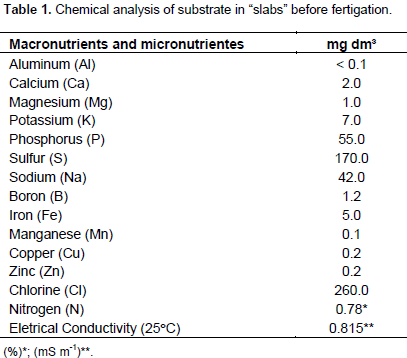
The efficiency of the acquisition and use of P (EAQ and EUTIL) and its components were obtained by means of the following expressions (Moll et al., 1982). For the efficiency of the P acquisition, we used the equation: EAQ = (Total content of P in the leaflet / Quantity of soluble P in the solution) and EUTIL = (Tomato production / total P in the leaflet). The phosphorus content in the nutrient solution was quantified at 90 DAT (mg L-1) in Natural Resources Laboratory, for spectrophotometer (HACH mod. DR 6000) and flame photometer (Analyser mod. 910 M) was used according to Okumura et al. (2004). During the experiment, six harvests of ripe fruit was carried out, compared to tomato groups. The results were submitted to analysis of variance. According to the theories recommended by Steel et al. (2006), the Scott-Knott test or t-test in order to evaluate the average was applied. The standard deviations were calculated and applied estimators of regression and correlation (Pearson or Spearman), using the SISVAR software (Ferreira, 2011).
Significant interactions between all the evaluated characteristics of phosphorus levels and tomato groups have been observed (Table 2). The EC has risen with the increase of doses of P2O5 for the groups "Santa Cruz and Cereja", to a maximum of 1.5 and 1.40 dS m-1. From the dose of 66 g P2O5 10 L-1, it was observed a decrease in EC (Figure 1A). At 60 DAT, regardless of tomato group, EC rose with increasing rates of P2O5. However at 110 DAT, the EC showed the maximum increase, 1.32 mS dm-1 at a dose of 66 g P2O5 10 L-1, from this value there was a decrease in EC for the "Cereja". The same trend of maximum increase of EC at a dose of 66 g P2O5 10 L-1 was observed for "Santa Cruz", reaching 0.97 dS m-1 in higher rates where there was a reduction in the EC. It has been noted that there was a difference of EC between the tomato groups, especially when compared to EC in "Cereja", which was higher than the EC in "Santa Cruz".
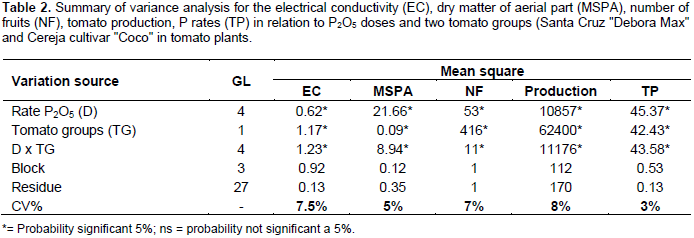
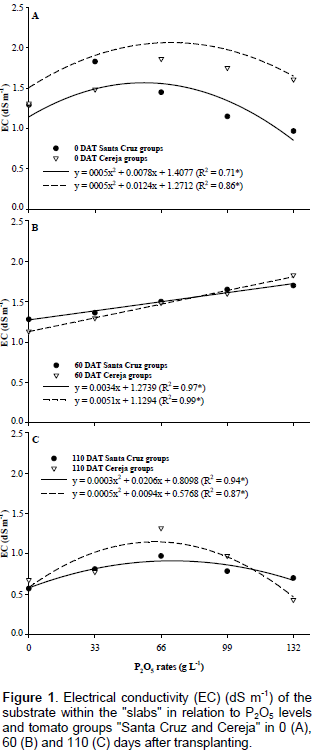
This may be related to the lack of homogeneity of the substrate, since the electrical conductivity is directly associated with the ionic concentration and the absorption of the nutrients by the culture during its development (Marschner, 1995). For Li and Stanghellini (2001) studying the effects of electrical conductivity and the potential of perspiration in the production of tomato plants cultivated in greenhouses, observed that with increasing concentration of nutrients in the nutritive solution, there was a significant decrease of production, mainly due to reduction of the size of the fruit, this is because of the lowest amount of water absorbed by the fruit. Since the dry mass of the fruits was not affected by high EC in the root zone. Researches related to the effects of EC in the production of roots and its effect on the decrease in production of eggplant fruits, and plant from the same access of tomatoes was reported by Marques et al. (2011).
With the growth of tomato plants, there was a reduction of EC, which is associated with greater cellular respiration, which provided higher absorption of P. The extraction and accumulation of nutrients by plants depends on other factors, from the EC, whose values are proportional to the concentration of the various ions responsible for the osmotic potential of the solution (Figure 1). For the concentration of P in leaf tissue (Figure 2), independent of P rates, the "Cereja" has accumulated the highest concentrations of P compared to the "Santa Cruz". The amount of nutrients absorbed by the tomato plant and its partitioning are usually associated with plant growth, production and depends on abiotic factors, including the fertilizer and tomato groups. The phosphorus (P) concentration in the nutritive solution drained from “slabs” quantified at 90 DAT for different groups of tomatoes is presented in Figure 2 (B).
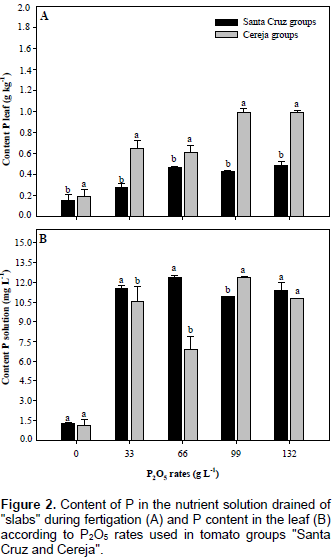
For the concentration of P in the control treatment, there was no significant difference between the groups of tomato plants. It is notable that although no addition of P in this treatment was detected, a trace of this element in solution P came from the substrate (Table 1) which did not affect the search results. With increasing concentrations of P in rates of 33 and 66 g P2O5 to 10 L-1 nutrient solution, the tomato "Cereja" showed the highest concentration of P in the solution. However, for the P concentration in the dose 99 g P2O5 to 10 L-1 in solution of “Cereja” was higher. On the other hand, for the dose of 132 g P2O5 to 10 L-1 a higher production for the "Santa Cruz" was noted (Figure 2). The dry matter production of aerial part (MSPA) expressed in grams plant-1, the tomato "Cherry and Santa Cruz" at rates of 0; 33 and 132 g of P2O5, when using 10 L-1 of nutrient solution provided no significant difference between the tomato groups.
However, with a dose of 66 g of P2O5 10 L-1 of nutrient solution, the production was higher in the group "Cherry". At rates 99 and 132 g of P2O5 10 L-1 of nutrient solution, the highest MSPA production was for Santa Cruz (Figure 3A). As for the number of fruits per plant (Figure 3B) Cherry "Cocco" was larger when compared to "Santa Cruz". According to Genuncio et al. (2010), the dry matter (leaflet + stem) for the Cherry tomato group is 93 g plant-1, and for the Santa Cruz group it was 64 g plant-1. For tomato yield it reaches 95%, the level of P in leaves should be between 1.7 to 3.0 g kg-1 (Silva et al., 2005). However for commercial tomato production (Figure 3C), the control treatment was higher for the "Santa Cruz" group. With the increase of the concentration of P in rates of 33; 66 g of P2O5 10 L-1 of nutrient solution, "Cherry" was the most productive when compared to "Santa Cruz".
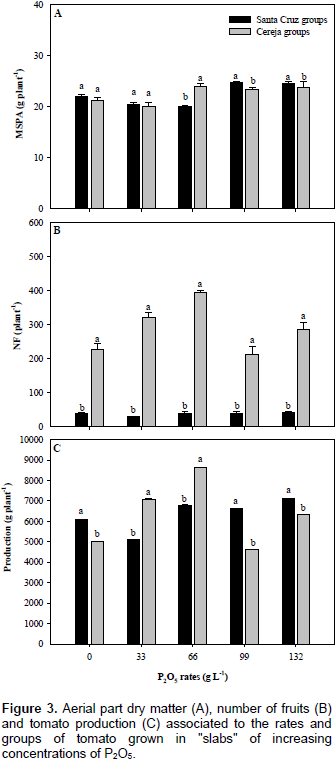
The highest production of fruits was observed with doses of 66 and 132 g of P2O5 10 L-1 of nutrient solution, where the maximum production was 8646 g plant-1 for the Cherry group and 6800 g plant-1 for Santa Cruz. It was observed that, at 0 and 132 g of P2O5 10 L-1 of nutrient solution, the phosphorus content in the ‘’slabs’’ (Table 1) was sufficient for the production of 6 and 5 kg of plant-1 of fruit for "Santa Cruz and Cherry", respectively. It was observed that "Cherry" was the most sensitive to the lack of phosphorus in the control treatment and to the dose of 132 g of P2O5 10 L-1 of nutrient solution. This difference may be related to greater nutritional needs of the "Santa Cruz" group, whose fruits are larger and, consequently, with greater nutritional need in relation to the "Cherry". These results corroborate the data of Alvarez et al. (2008), citing that plant species have different abilities to absorb P2O5, which allows the use of this characteristic to distinguish genotypes with high efficiency for absorption of P2O5 in soil solution or genotypes that have tolerance to low levels of this nutrient.
In order to evaluate the adaptation of cultivars and/or hybrids to the protected cultivation of tomatoes, variations in productivity were verified due to interactions between genotypes and environments and cultural practices adopted in different trials (Caliman et al., 2005). When genotypes with high productive potential and management of favorable environmental conditions are associated, high yields are obtained, increasing production from 25 to 40% due to early maturation, better uniformity, higher initial vigor and development, better fruit quality and resistance to diseases (Melo et al., 2009). The occurrence of genotypic variability, due to its tolerance to low phosphorus content has been reported in several economically important crops, including tomato. However, information on use efficiency phosphorus and nutrients for these varieties are very small.
According to Moraes (1997), there is a need for more detailed information on the mineral nutrition of tomato in protected cultivation, since these are essential for the definition of adequate doses of fertilizers, aiming at maximum efficiency and high quality of fruits. The efficiency in the use of P in dry matter, the leaf and the EUMS (efficient use of P in dry matter) was superior to the control treatment, in the group "Santa Cruz". The "Santa Cruz" presented higher EUMS in comparison to the "Cereja" due to increase in the P2O5 levels. There was no significant difference at the dose of 66 g P2O5 10 L-1 of nutrient solution (Figure 4A). In the Figure 4 (B), the same trend was observed for "Santa Cruz", regardless of P2O5 rate, there was a higher EUTIL (tomato production/total P in the leaf) compared to the “Cereja”.
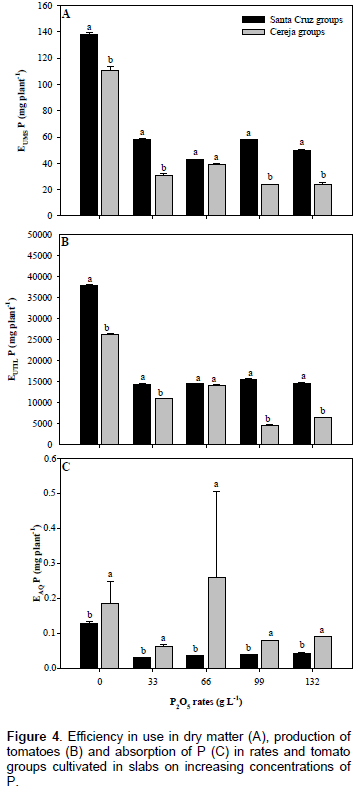
For the absorption efficiency of P (EAQ), regardless of the phosphorus levels used, “Cereja” was superior compared to the “Santa Cruz” (Figure 4 C). Studies on the efficiency in the use of P, based on the genotypic variability, aimed at tolerance to low phosphorus content has been reported in several crops of economic importance (Silva and Gabelman, 1992). In Brazil, countless works were conducted to evaluate the morphological and agronomical characteristics, fruit quality and edaphoclimatic adaptation of tomato cultivars, including cultivars “Santa Cruz and Santa Clara” configured as progenitor of important genotypes (Silva, 1996; Peixoto et al., 1999).
The electrical conductivity on the slab substrate was not homogeneous. The correct supply of nutrients in the substrate can increase the electrical conductivity, so it is necessary to recondition the substrate before sowing, in order to reduce the electrical conductivity. For the tomato group “Cereja and Santa Cruz”, phosphate fertilizer provided the best yields when applying the dose of 66 g P2O5 to 10 L-1 of nutrient solution to the "slabs". An important advantage of using "slabs" in tomato plants is the efficiency of the use of phosphorus in the first sowing, providing a better crop yield and better plant growth.
The authors have not declared any conflict of interests.
REFERENCES
|
Alvarenga MAR (2004). Tomate: Produção em campo, em casa de-vegetação e em hidroponia. Lavras: UFLA. P 400.
|
|
|
|
Alvarez JM, Rocha JF, Machado SR (2008). Bulliform cells in Loudetiopsis chrysothrix (Nees) Conert and Tristachya leiostachya Nees (Poaceae): structure in relation to function. Braz. Arch. Biol. Technol. 51(1):113-119.
Crossref
|
|
|
|
|
Blanco FF, Folegatti MV, Nogueira MCS (2002). Fertigation with saline water and its effects on yield of greenhouse grafted cucumber. Hort. Bras. 20(3):442-446.
Crossref
|
|
|
|
|
Caliman FRB, Silva DJH, Fontes PCR, Stringheta PC, Moreira GR, Cardoso AA (2002). Avaliação de genótipos de tomateiro cultivados em ambiente protegido e em campo nas condições edafoclimáticas de Viçosa. Hort. Bras. 23:5068-5074.
|
|
|
|
|
Cararo DC, Duarte SN (2002). Injeção de CO2 e lâminas de irrigação em tomateiro sob estufa. Hort. Bras. 20:432-437.
Crossref
|
|
|
|
|
Carvalho C, Kist BB, Treichel M (2016). Anuário Brasileiro do Tomate 2016. Santa Cruz do Sul; Editora Gazeta Santa Cruz. P 84.
|
|
|
|
|
CPTE/INPE (2017). Available in:
View. Accessed on May 25. 2017.
|
|
|
|
|
Ferreira D (2011). Sisvar: a computer statistical analysis system. Ciênc. Agrotec. 35(6):1039-1042.
Crossref
|
|
|
|
|
Fontes PCR, Loures JC, Galvão AA, Mantovani EC (2004). Tomato production and quality in soilless culture conducted in the field and under unheated greenhouse. Hort. Bras. 22(3):614-619.
Crossref
|
|
|
|
|
Genuncio GC, Renata ACS, Núbia MS, Everaldo Z, Adelson PA (2010). Production of tomato cultivars in hydroponics and fertigation with different ratios between nitrogen and potassium. Hort. Bras. 28(4):446-452.
Crossref
|
|
|
|
|
Gualberto R, Braz LT, Banzatto DA (2002). Produtividade, adaptabilidade e estabilidade fenotípica de cultivares de tomateiro sob diferentes condições de ambiente. Pes. Agrop. Bras. 37:81-88.
Crossref
|
|
|
|
|
Gul A, Erogul D, Ongun D (2005). Comparison of the use of zeolite and perlite as substrate for crisp-head lettuce. Sci. Hort. 106(4):464-471.
Crossref
|
|
|
|
|
Holler HC (2015). Slabs: técnica promissora para produzir morangos. 2015. Available in:
View. Accessed on May 25. 2017.
|
|
|
|
|
Li YL, Stanghellini C (2001). Effect of electrical conductivity and transpiration on production of greenhouse tomato (Lycopersicon esculentum L.). Sci. Hort. 88(1):11-29.
Crossref
|
|
|
|
|
Loures JL, Fontes PCR, Sediyama MAN, Casali WD, Cardoso, AA (1998). Fruit yield and nutrient contents in tomato plants grown in substrate containing swine manure. Hort. Bras. 16(1):50-55.
|
|
|
|
|
Malavolta E, Vitti GC, Oliveira AS (1997). Evaluation of nutritional status of plants: Principles and applications. 2nd ed. Potafos; Piracicaba (Brazil). P 319.
|
|
|
|
|
Marques DJ, Broetto F, Silva EC, Carvalho JG (2011). Dynamics of root cations and leaves of eggplant cultivated on increasing doses of potassium from two sources. Idesia. 29:69-77.
Crossref
|
|
|
|
|
Marques DJ, Broetto F, Ferreira MM, Lobato AKS, Ávila FW (2014). Effect of potassium sources on the antioxidante activity of eggplant. Rev. Bras. de Ciên. do Solo. 38:1836-1842.
Crossref
|
|
|
|
|
Marschner H (1995). Mineral nutrition of higher plants. 2. ed. London: Academic Press, P 889.
|
|
|
|
|
Melo PCT, Tamiso LG, Ambrosano EJ, Schammass E, Inomoto MM, Sasaki Mem, Rossi F (2009). Desempenho de cultivares de tomateiro em sistema orgânico sob cultivo protegido. Hort. Bras. 27:553-559.
Crossref
|
|
|
|
|
Moll RH, Kamprath EJ, Jackson WA (1982). Analysis and interpretation of factors which contribute to efficiency of nitrogen utilization. Agron J. 74:562-564.
Crossref
|
|
|
|
|
Moraes CAG (1997). Floating: How to cultivate tomatoes in NFT system. DISQ Editora; Jundiaí (Brazil). P 143.
|
|
|
|
|
Novais RF, Smyth TJ (1999). Fósforo em solo e planta em condições tropicais. Viçosa: UFV, Departamento de Solos. P 399.
|
|
|
|
|
Okumura F, Cavalehiro ETG, Nóbrega JA (2004). Simple flame photometric experiments to teach principles of atomic spectrometry in undergraduate analytical chemistry courses. Q. Nova. 27(4):832-836.
Crossref
|
|
|
|
|
Peixoto JR, Oliveira CM, Silva RP, Angelis B, Cecílio Filho BA (1999). Evaluation of tomato genotypes (Santa Cruz type) during the winter season, in Araguari, MG, Brazil. Pes. Agrop. Bras. 34(12):2247-2251.
Crossref
|
|
|
|
|
Riviere LM, Caron J (2001). Research on substrates: state of the art and need for the coming 10 years. Act. Hort. 548(1):29-41.
Crossref
|
|
|
|
|
Silva EC, Maluf WR (2012). Hydroponic technique for screening of tomato genotypes for phosphorus uptake efficiency. Hort. Bras. 30(2):317-321.
Crossref
|
|
|
|
|
Silva MP, Riva EM, Amaral Júnior AT (2005). Aplicação de métodos de agrupamento na quantificação da divergência genética entre acessos de tomateiro. Hort. Bras. 23:1000-1005.
Crossref
|
|
|
|
|
Silva AE, Gabelman WH (1992). Screening maize inbred lines for tolerance to low-P stress condition. Plant Soil. 146(1): 181-187.
Crossref
|
|
|
|
|
Silva RP (1996). Evaluation of tomato genotypes (Santa Cruz type) during the summer season, in Araguari, MG, Brazil. Universidade Federal de Uberlândia.
|
|
|
|
|
Steel RGD, Torrie JH, Dickey DA (2006). Principles and procedures of statistics: a biometrical approach. 3rd ed. Academic Internet Publishers; Moorpark (USA). P 666.
|
|